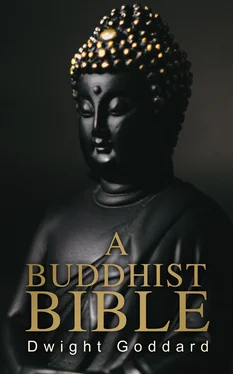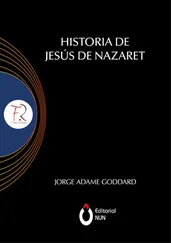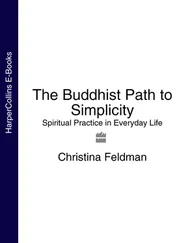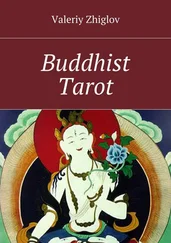The next outstanding name, and the one to whom is usually given the chief credit for being the founder of Ch’an Buddhism in China, is Bodhidharma. He was an Indian monk of princely family who must have arrived in South China about 470 A.D., and who lived and travelled in China for fifty years until about 520. This length of stay in China is much longer than is usually given but it appears to be necessary to account for all that is recorded concerning him. He must have been a most extraordinary man, a great personality, stubborn, taciturn, gruff and positive, but withal, honest, straightforward and clear minded. There are two incidents in his life that will bear repeating. Emperor Wu of Liang was very favorably inclined toward Buddhism; he founded temples, supported monks, and translated scriptures, but when he asked Bodhidharma during an interview what credit he had earned, the gruff old monk replied, "None whatever, your majesty." To the question, "What is the first principle of the holy doctrine?" Bodhidharma replied, "Vast emptiness, and there is nothing in it to be called 'holy,' Sire."
"Who is it, then, that confronts me?" asked the Emperor.
"I do not know, Your Majesty."
There is a famous poem that refers to the above incident, that has for these present times a deep significance:
"I don't know," replied Bodhidharma,
Baffled by the classical speech of the Imperial Court;
But if the Emperor had been a man of insight and spirit
He would have chased after Bodhidharma,
Over the desert sand to Tien-mu."
Bodhidharma, finding in the North no interest in his presentation of Buddhism, returned to the South and shut himself in his own monastery of Shao-lin, to which few disciples ever came and where, tradition says, he practised for nine years a kind of concentrative dhyana that came to be called, "wall gazing." It consisted in an honest and earnest effort to definitely realise the oneness of one's true Buddha-nature with Universal Buddhahood, by the single method of mind-concentration on Mind-essence. To Bodhidharma, books, logical ideas, study, ritual, worship were useless; only simple but "seeking" and tireless "wall-gazing" was sufficient. All distinctions of self and not-self, comfort or discomfort, joy or suffering, desire or aversion, success or failure, and mental discrimination of all kinds must be ignored and left behind, in the sole effort to merge oneself with Mind-essence which alone is reality, Inasmuch as one's own inner conscience is Mind-essence, why seek for it elsewhere? This "treasure of the heart" is the only Buddha there ever was, or is, or ever will be. "There is no Buddha but your own. thoughts. Buddha is Tao. Tao is dhyana. Dhyana cannot be understood by the definitions of the wise. Dhyana is a man's successful seeing into his own fundamental nature." "I have come from India only to teach you that Buddha is thought. I have no interest in monastic rules, nor ascetic practises, nor miraculous powers, nor merely sitting in meditation."
In Bodhidharma's distrust of scriptures and intellectual knowledge, he made an exception of the Lankavatara Sutra. The reason for this exception was because that Sutra alone taught the doctrine of the Self-realisation of the Oneness of all things in Mind-essence. When at last after nine years of "wall-gazing" he gained one disciple who understood him, Hui-k’e (486-593). Bodhidharma gave him certain instruction that could only be transmitted from mind to mind, and gave him his begging-bowl and his robe and his copy of the Lankavatara Sutra, which afterward became the insignia of the Patriarchate, thus constituting Hui-k’e as the Second Patriarch. There is a tradition that Bodhidharma soon after returned to India, but the place and time of his death is unknown.
There is no doubt that at first and for a long time the "Sudden Awakening" Ch’an school was a hard one to attend. It was well over the border of asceticism and self-denial, with no marks of sympathy between Master and disciple to make it bearable, but from that hard school rose a succession of great Masters and deep experiences and an extraordinarily virulent social influence.
Concerning the teachings of Bodhidharma and the Ch’an sect, Dr. Suzuki quotes the following passage:
"The Master (Bodhidharma) first stayed in Shao-lin Temple for nine years and when at last he taught the Second Patriarch it was in this manner. Externally keep yourself away from all relationships, and internally cherish no hankerings in your heart. When your mind becomes like an upright wall (that is, resistant to the entrance of discriminative ideas) you will enter into the path. At first Hui-k’e tried in various ways to explain (to himself) the reason of mind-only but failed to realise the truth itself. The Master would say: 'No, no,' but would do nothing to explain it or make clear what Mind-essence in its undifferentiated, no-thought, state might be. Later on Hui-k’e said to the Master, 'Now I know how to keep myself away from all relationships.' When the Master asked him to demonstrate it, Hui-k’e replied: 'I know it always in a most convincing manner but to express it in words--that is impossible.' Thereupon said the Master, 'That is the Mind-essence itself that is transmitted by all the Buddhas. Have no doubt about it.'"
The story runs that Hui-k’e before he was finally successful had tried again and again to gain Bodhidharma's consent to become his Master, even waiting at his gate one cold winter's night while the snow fell to his knees, and was finally successful only when he cut off his right arm to show the earnestness of his desire. Hui-k’e was very learned in the Chinese classics and also in the common lore of Buddhism; he seems to have come to Bodhidharma at first more to win his approval than with any great expectation of added instruction, but after he had attained his deep experience with Bodhidharma, he made light of his great learning, became very humble minded and earnestly' sought for perfect enlightenment. After the passing of Bodhidharma, Hui-k’e did not at once assume leadership as the Second Patriarch, but withdrew to a hermitage in the mountains and lived quite humbly with the lowest classes of society. He did not shun preaching but tried to do it quietly and inconspicuously. He was finally murdered by an envious Master whose disciples Hui-k’e had unintentionally drawn away.
The Third Patriarch was Seng-ts’an ( -606) about whom very little is known. One tradition has it that he suffered from leprosy and therefore retired to a hermitage in the mountains. There is a record of his transmitting the begging-bowl and the robe to Tao-hsin (580-651). Tao-hsin was also a recluse and very little is known of him except that he left a composition which has always been highly valued by disciples of Ch’an Buddhism.
The Fifth Patriarch was Hung-jen (605-675). It is recorded of him that he was a near neighbor or relative of Seng-ts’an and came to be with him when quite young. With his assumption of the Patriarchate there was introduced a decided change in the character of the presentation of Ch’an Buddhism. Hitherto the Patriarchs had been of a retiring disposition, or else the times had changed making it possible for the Masters to work more publicly and assemble disciples. At any rate we find Hung-jen the head of a great establishment with hundreds of disciples and attaining imperial favor.
Among the disciples of Hung-jen were two who afterwards came into great public notice; Hui-neng whose Sutra we shall study in the following chapters and Shen-hsui, who was second only in rank in the great monastery to Hung-jen. Shen-hsui was a very learned man and a notable orator and teacher, but he was egoistic and deficient in the insight that marks the true Ch’an Master. Hung-jen was aware of this and so when the time came for him to appoint a successor, he passed by Shen-hsui and appointed Hun-neng. Having failed in securing the coveted rank of Sixth Patriarch, Shen-hsui returned to the North from whence he had originally come and there established a rival school that for a time was very successful and he came to be highly honored by the Emperor. His school differed from that of Hung-jen and came to be known as the "Gradual Attainment," or Northern School of Ch’an Buddhism, but at his death it was less successful and finally lost standing.
Читать дальше












